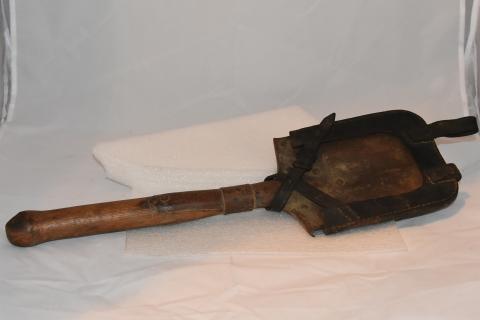This is an entrenching tool of German origin. It consists of a heavy wooden shaft about 1 foot in length which connects to the metal shovel head at one end. The shovel head is secured to the shaft by two metal plates which are screwed into the top and bottom of the wooden shaft and by a circular socket below those plates. The shovel itself is a single sheet of bent metal which curves upwards from its central line. It's tip is square, not pointed. It is covered by a leather protective case which surrounds the exterior perimeter of the shovel. The case has two leather straps on the tip of the shovel head which would have served as carrying hooks for the tool in a soldier's kit. The case is secured to the shovel by two leather straps which are linked together by a metal clasp and adjustable leather loop. The metal portion of the tool has suffered from extensive corrosion damage and significant discoloration. The leather case has since hardened and is incredibly stiff and dry. Entrenching tools of this kind were implemented in the First World War by both the Russian and German armies. As the war progressed and trench warfare became more widespread, entrenching tools were absolutely essential pieces of personnel equipment. There are also rumored instances in which soldiers utilized their trench shovels as bludgeons in close quarters combat with enemy troops, although many of these rumors are unsubstantiated. SS.4.25: Technological Change This content can be used to educate students on the evolution of military trench technology and how that evolution extended to impact the service of Iowa soldiers in the First World War. For any use other than instructional resources, please check with the organization that owns this item for any copyright restrictions.
2018.002.044 [Shovel, Trench]
Legal Status
Copyright to this resource is held by the Iowa Masonic Library and Museum and has been provided here for educational purposes only, specifically for use in the Iowa Museum Association's "Teaching Iowa History" project. It may not be downloaded, reproduced or distributed in any format without written permission from the Rights Holder. For more information on U.S. and International copyright laws, consult an attorney.

